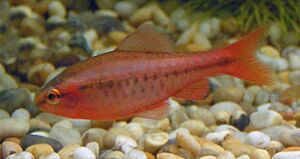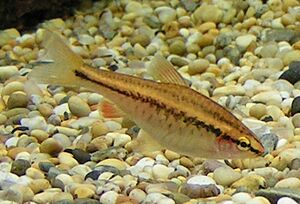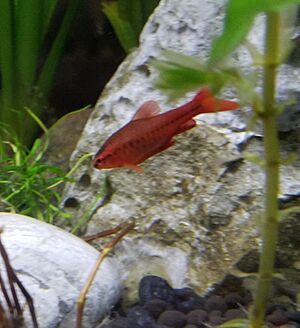Cherry barb facts for kids
Quick facts for kids Cherry barb |
|
|---|---|
 |
|
 |
|
| male above, female below | |
| Conservation status | |
| Scientific classification | |
| Synonyms | |
|
Barbus titteya (Deraniyagala, 1929) |
The cherry barb (scientific name: Puntius titteya) is a small, colorful freshwater fish. It lives in warm, tropical waters. This fish is part of the Cyprinidae family, which includes many types of minnows and carps.
Cherry barbs originally come from the island country of Sri Lanka in Asia. You can also find them in places like Mexico and Colombia, where they were brought by people. A scientist named Paules Edward Pieris Deraniyagala first gave the cherry barb its scientific name in 1929.
These fish are very popular in the aquarium hobby because they are pretty and easy to care for. Many are raised on farms for this reason. However, it's important to protect them in their natural homes.
Contents
What Does a Cherry Barb Look Like?
The cherry barb is a small, slender fish. It has a body that is a bit flattened on the sides. These fish usually grow to be about 5 centimeters (2 inches) long.
Male and female cherry barbs look different:
- Females are often a light brown color on top. They might have a slight green shine. Their sides and belly often look shiny and silver. Sometimes, they have a pinkish color on their back. A dark line runs from their nose, through their eye, to their tail.
- Males are usually reddish. When they are ready to breed, their color becomes a very deep red. They also have a thinner body shape than females.
Where Do Cherry Barbs Live?
In the wild, cherry barbs live in places with lots of shade. They like shallow, calm water. Their natural homes often have a muddy bottom covered with fallen leaves.
These fish come from a tropical climate. They prefer water that is between 23°C and 27°C (73°F to 81°F). They also like water that is not too acidic or too basic, with a pH between 6 and 8.
Cherry Barbs in Aquariums
Many people keep cherry barbs in their home aquariums. These fish are usually peaceful and get along well with other fish.
Cherry barbs are schooling fish, which means they like to swim together in groups. It's best to keep at least five or more of them together. This helps them feel safe and happy.
When keeping cherry barbs, it's a good idea to have more females than males. For example, try to have at least two females for every male. This is because male cherry barbs can be quite active when they want to breed. Having more females helps spread out their attention.
Cherry barbs usually live for about four years, but some can live up to seven years. Their tank should have lots of plants, covering about two-thirds of the space. This gives them places to hide and feel secure. They also need some open space to swim around.
How Do Cherry Barbs Have Babies?
When it's time to breed, the male cherry barb will chase the female. He tries to keep other males away. The female will lay between 200 and 300 tiny eggs. She scatters them on plants and on the bottom of the tank.
Sometimes, the adult fish might eat their own eggs or tiny babies. The eggs usually hatch in just one to two days. After another two days, the baby fish (called fry) will start swimming freely. When they are about five weeks old, they will be about 1 centimeter long. At this size, you can easily tell they are cherry barbs!



